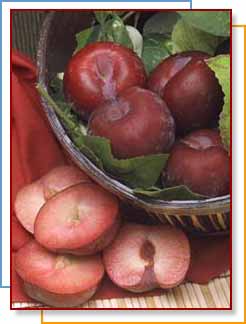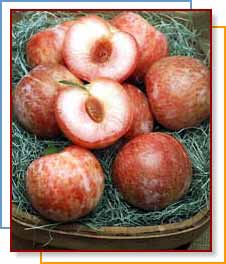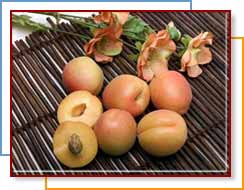
*Pluot© and Aprium© are registered trademarks of Zaiger Genetics,
Modesto, California
Pluots are complex hybrid fruits that are part plum and part apricot in
heritage. These fruits were originally invented in the late 20th century
by Floyd Zaiger and are now grown in parts of Washington and California.
Pluots have a majority of plum parentage and therefore, have smooth skin
like plums. Some varieties of pluots are sometimes called interspecific
plums, or dinosaur eggs. The pluot is often confused with the aprium which
is another plum and apricot hybrid with mostly apricot heritage. Like
apricots, apriums have slightly fuzzy skin. Pluots and apriums are known
for their sweetness and flavor; the sugar content of these fruits is much
higher than that of a plum or apricot alone.
|
Pluot and Aprium nutritional information is not
available at this time. |
|
Plum
|
Serving size
1/2 cup (83g)
|
Amounts
Per Serving |
% Daily
Value |
| Calories
70 |
|
| Calories
from Fat 0 |
|
| Total Fat
1g |
2% |
| Saturated
Fat 0g |
0% |
| Sodium
0mg |
3% |
| Total
Carbohydrate 9g |
3% |
|
Dietary Fiber 1g |
4% |
|
Sugars 8g |
|
| Protein
1g |
|
| Vitamin A |
6% |
| Vitamin C |
15% |
| Calcium |
0% |
| Iron |
0% |
Percent Daily Values are based on a
2,000 calorie diet.
|
|
|
|
Apricot
|
Serving size
1/2 cup (83g)
|
Amounts
Per Serving |
% Daily
Value |
| Calories
40 |
|
| Calories
from Fat 5 |
|
| Total Fat 0g |
0% |
| Saturated
Fat 0g |
0% |
| Sodium
0mg |
0% |
| Total
Carbohydrate 9g |
3% |
|
Dietary Fiber 1.65g |
6% |
|
Sugars 7.6g |
|
| Protein
1g |
|
| Vitamin A |
30% |
| Vitamin C |
15% |
| Calcium |
2% |
| Iron |
2% |
Percent Daily Values are based on a
2,000 calorie diet.
|
|
| |
|
|
Pluot and aprium season stretches from May to September. Pluots can be
found mostly in milder climates.
Pluots and apriums should be plump and firm. Avoid pluots that are
green, blemished, or have broken skin.
Pluots and apriums should be ripened at room temperature and then
refrigerated. Pluots can be ripened in a brown paper bag at room
temperature.
Fruit should be washed well and dried before consumption. To remove
pit, cut the fruit in half. Pluots and apriums can be eaten fresh or
cooked.
 Approximately 20 varieties of pluots have been developed and bred by
Zaiger Genetics. Each variety contains a different percentage of plum and
apricot parentage. These varieties vary in size, skin color, and flesh
color. The skin can be solid, striped, or speckled and skin colors range
from yellow-green to black. Pluot flesh ranges from white to red in color. Approximately 20 varieties of pluots have been developed and bred by
Zaiger Genetics. Each variety contains a different percentage of plum and
apricot parentage. These varieties vary in size, skin color, and flesh
color. The skin can be solid, striped, or speckled and skin colors range
from yellow-green to black. Pluot flesh ranges from white to red in color.
There is only one variety of aprium currently on the market. The Honey
Rich interspecific is bright orange and has bright orange flesh.
Pluot varieties include:
- Candy Stripe: medium, pink-yellow striped, with very sweet and juicy
flesh.
- Cherry: small, bright red skin with white flesh.
- Dapple Dandy: large sweet with pale green to yellow, red-spotted
skin, red or pink juicy flesh.
- Flavorella: round, medium-sized, golden-yellow, with sweet and juicy
flesh.
- Flavor Heart: very large, black with a heart shape, and yellow
flesh.
- Flavor King: very sweet, medium or large, with red-purple skin and
red flesh.
- Flavorosa: very sweet or tart, medium-sized, flat round dark-purple
fruit with red flesh.
- Flavor Prince: large round and purple, with red flesh.
- Flavor Rich: medium-sweet, large black round fruit with orange
flesh.
- Flavor Supreme: medium or large, greenish purple skin, juicy red
flesh.
- Flavor Queen: large light-green to yellow, very juicy.
- Red Ray: medium, bright red with dense, sweet orange flesh.
Recipes
*All recipes were analyzed using plums or apricots
 Confetti
plum (pluot)-pasta salad Confetti
plum (pluot)-pasta salad
Makes 6 servings
Each serving equals 1/2 cup of fruit or vegetables
Source: Fruits & Veggies—More Matters Better Health Cookbook
Ingredients
8 ounces corkscrew pasta
½ medium red bell pepper, cut into strips
¾ cup peeled and diced jicama
½ cup chopped red onion
8 pluots, sliced
2 Tbsp diced pimento
1 tsp finely grated fresh ginger
3 Tbsp rice or white wine vinegar
1 Tbsp vegetable oil
1/8 tsp salt
1/8 tsp freshly ground black pepper
Cook the pasta according to the package directions. Drain. Rinse
briefly under cold water and drain. In a large bowl, toss together the
pasta, red and yellow bell peppers, jicama, onion, and pluots.
In a small bowl, whisk together all the basil, pimento, ginger, vinegar,
oil, salt, and pepper until blended. Drizzle the dressing over the salad
and toss evenly until coated.
Nutritional analysis per serving: Calories 216, Protein 6g, Fat 3g,
Calories From Fat 14%, Cholesterol 0mg, Carbohydrates 42g, Fiber 4g,
Sodium 43mg.

Find more in our
recipe database!
|



